A Guide to Mother Sauces
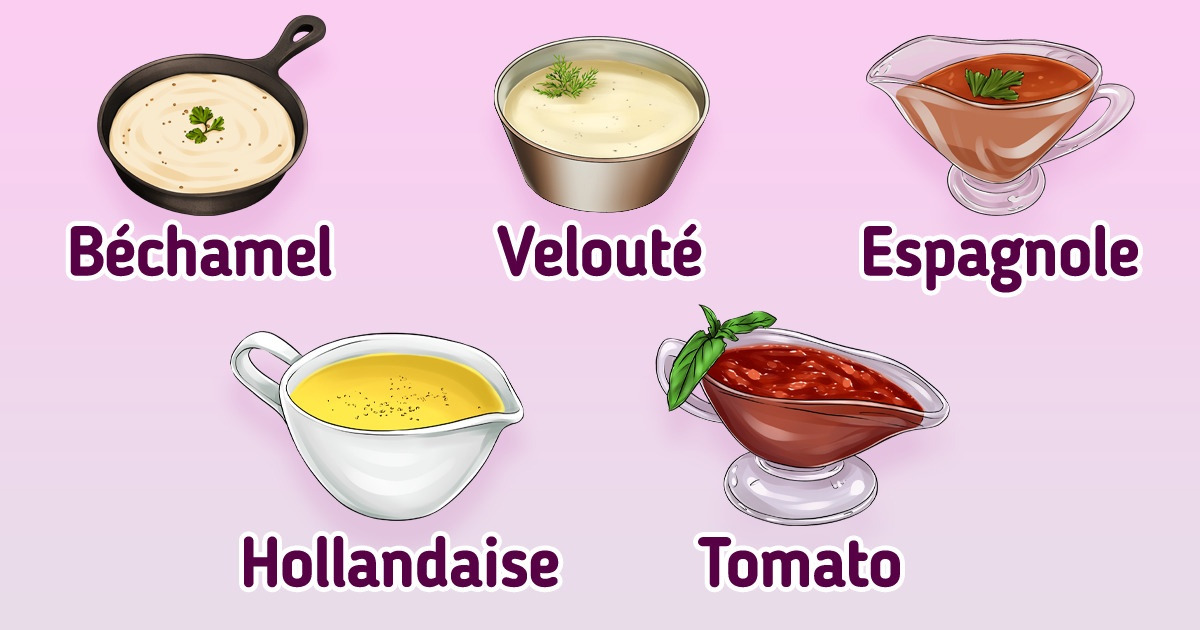
It’s believed that there are 5 basic sauces in classic cuisine that are the starting points of all other sauces. Each one is made with a different liquid and a thickener, although 3 of them are thickened with butter and flour.
These “mother sauces” are béchamel, velouté, espagnole, hollandaise, and classic tomato. 5-Minute Crafts would like to tell you about how to use and make these sauces.
Béchamel
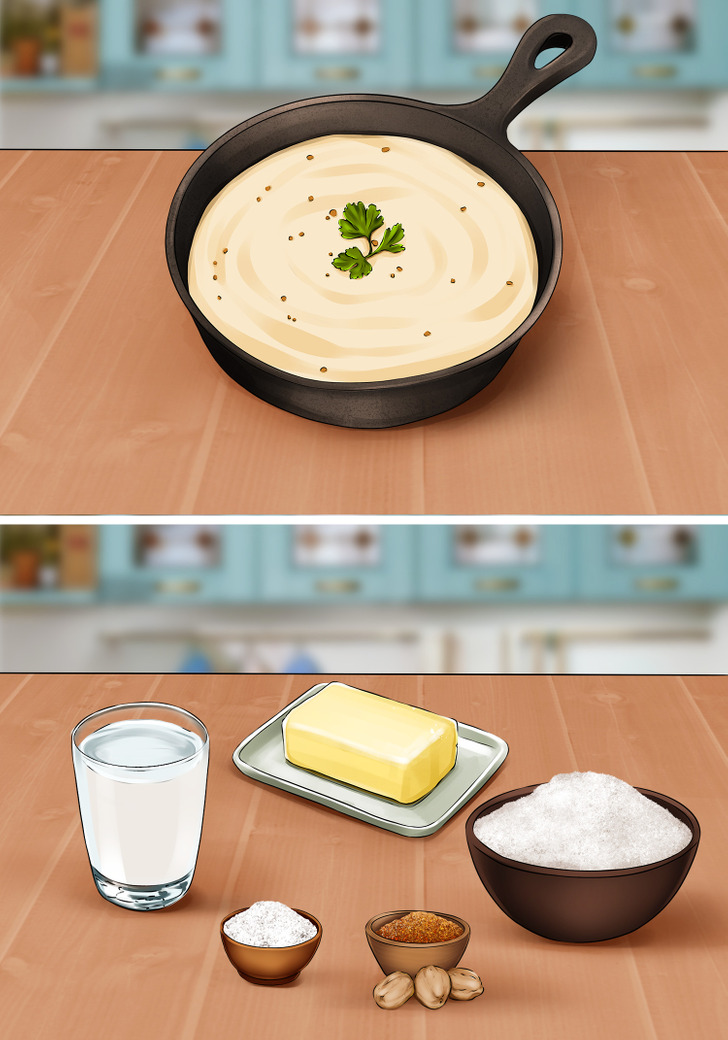
You’ll need:
- 2 cups of milk
- 1.7 ounces of unsalted butter
- 1.7 ounces of all-purpose flour
- 1/4 teaspoon of fine salt
- Nutmeg
1. Prepare all the ingredients in advance.
2. Melt the butter in a heavy-bottomed pot over low heat.
3. Slowly begin to stir the flour into the melted butter until it becomes a smooth, pale yellow paste. Don’t overheat this paste, it should be moderately warm.
4. Heat the milk in a heavy-bottomed saucepan or pot over medium heat. Stir occasionally to keep it from overheating and boiling.
5. Start adding milk to the paste, whisking vigorously. Make sure there are no lumps in the sauce.
❗ After adding milk, don’t forget to constantly stir the sauce to prevent the formation of lumps. Don’t let the flour brown.
6. Cook over low heat for 15 minutes or until the consistency is thick enough.
7. The finished sauce should be smooth and velvety, not too thick, and not runny. If the sauce has thickened too much, add some milk to it and stir.
8. Remove the sauce from the heat, and carefully pour the sauce through a fine-mesh strainer. To get an even smoother consistency, use a cheesecloth along with the strainer.
9. Season the sauce with salt, and add a pinch of nutmeg.
Velouté
Veloute, just like béchamel, is a creamy white sauce. The main difference between the 2 is that the velouté sauce is made with broth, while béchamel is made with milk.
There are 3 main types of broth: chicken, veal, and fish. Therefore, there are 3 types of velouté sauce. Still, chicken broth is most commonly used.
Like béchamel, velouté can become the base for the preparation of other more complex sauces that have many components.
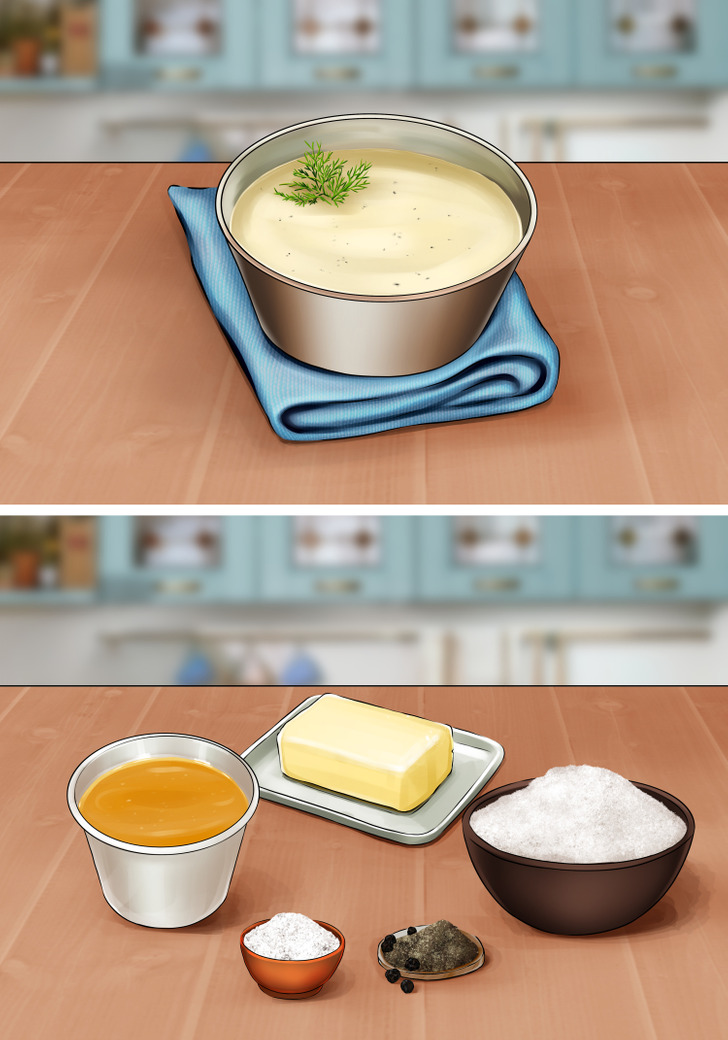
To make chicken velouté, you’ll need:
- 1.5 cups of chicken broth
- 2 tablespoons of clarified butter or regular butter
- 3 tablespoons of all-purpose flour
- Salt and pepper to taste
Cooking process:
1. Prepare all the ingredients.
2. Bring the broth to a boil in a small pot, then reduce the heat to keep the broth hot.
3. Melt the butter in another heavy-bottomed pot. Be careful not to overheat it so that it doesn’t turn brown.
4. Gradually start mixing the flour into the melted butter. Continue until a smooth, pale yellow paste is formed.
5. Heat up the resulting paste for several minutes, but don’t let it turn brown. The sauce should retain its light color.
6. Using a whisk, slowly add the hot broth to the paste. Beat vigorously so that there are no lumps of flour left in the sauce. Pour all the broth this way.
7. Cook the sauce over low heat for about 30 minutes or until its total volume is reduced by 2 times. Remember to stir the contents of the pot constantly to prevent the sauce from browning.
8. Cook the sauce until smooth. Check whether it’s ready by dipping the back of a spoon into it. It should coat the spoon without running off it. If the sauce is too thick, add broth to it and cook for some more time.
9. Add salt and pepper to taste.
10. Strain the sauce through a sieve with cheesecloth to get a more smooth, velvety consistency.
Espagnole
Espagnole is a basic brown sauce that first appeared in Spain in the late nineteenth century and quickly became popular. It’s based on a brown roux (a mixture of butter and flour), veal broth, tomatoes, and a chopped mixture of vegetables.
Espagnole is a starting point for many other sauces and is often served with meat.
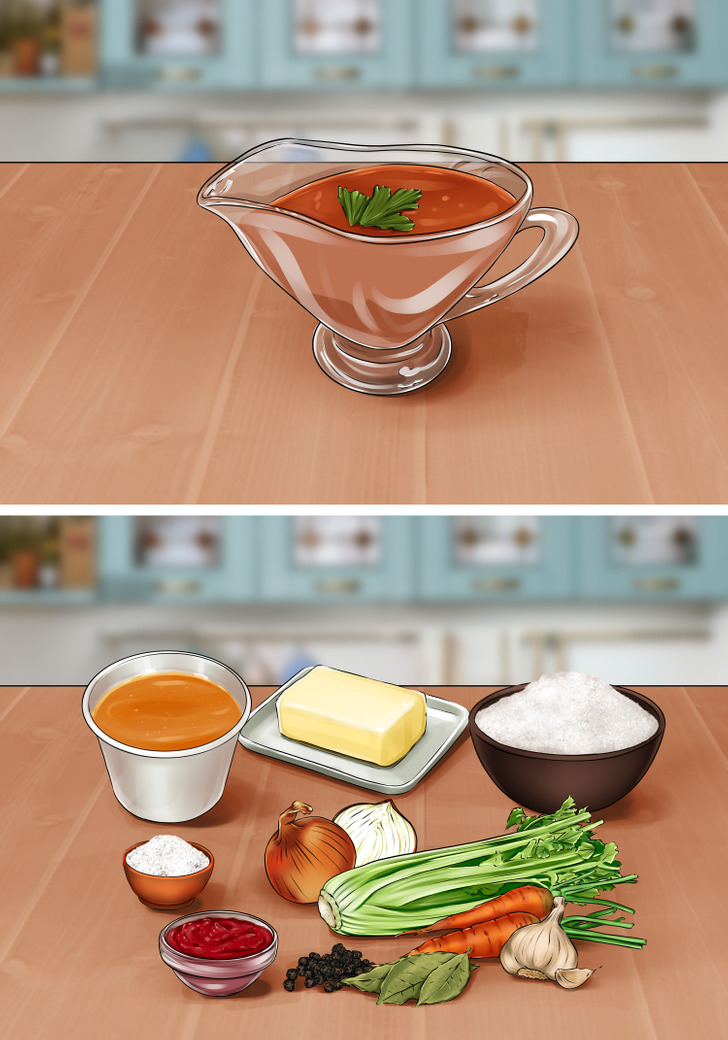
You’ll need:
- 1/4 cup of diced carrots
- 1/2 cup of diced onions
- 1/4 cup of diced celery
- 1/2 stick of unsalted butter
- 1/4 cup of all-purpose flour
- 4 cups of hot beef broth (or veal broth)
- 1/4 cup of canned tomato purée
- 2 large garlic cloves, minced
- Salt
- 1/4 teaspoon of whole black peppercorns
- 1 bay leaf
Cooking process:
1. In a heavy-bottomed saucepan set over medium heat, saute onions and carrots with a pinch of salt in the butter until softened (about 6-7 minutes). Don’t forget to stir the vegetables while cooking.
2. Reduce the heat to a minimum and add the flour, stirring slowly. Cook the mixture until golden brown, about 6-10 minutes.
3. Constantly stirring the mixture with a whisk, pour hot broth into it. Stir vigorously so that no lumps remain in the sauce.
4. Add the tomato purée, chopped garlic, celery, peppercorns, and bay leaf.
5. Bring the mixture to a boil, then reduce the heat and simmer uncovered, stirring constantly to avoid burning the sauce.
6. Reduce the liquid by about 1/3. This may take you about 35-40 minutes.
7. Check whether the sauce is ready — it should cover the spoon tightly without running off it.
8. Pour the sauce through a sieve into a bowl to get a smooth texture.
Hollandaise
Hollandaise is a tangy, buttery sauce based on warm egg yolks whisked with clarified butter. It can be served with seafood, pizza, vegetables, or eggs, or used as a starting point for more complex sauces.
❗ The sauce is emulsified, which is why clarified butter is used in it and not ordinary butter. It helps the emulsion to remain stable.
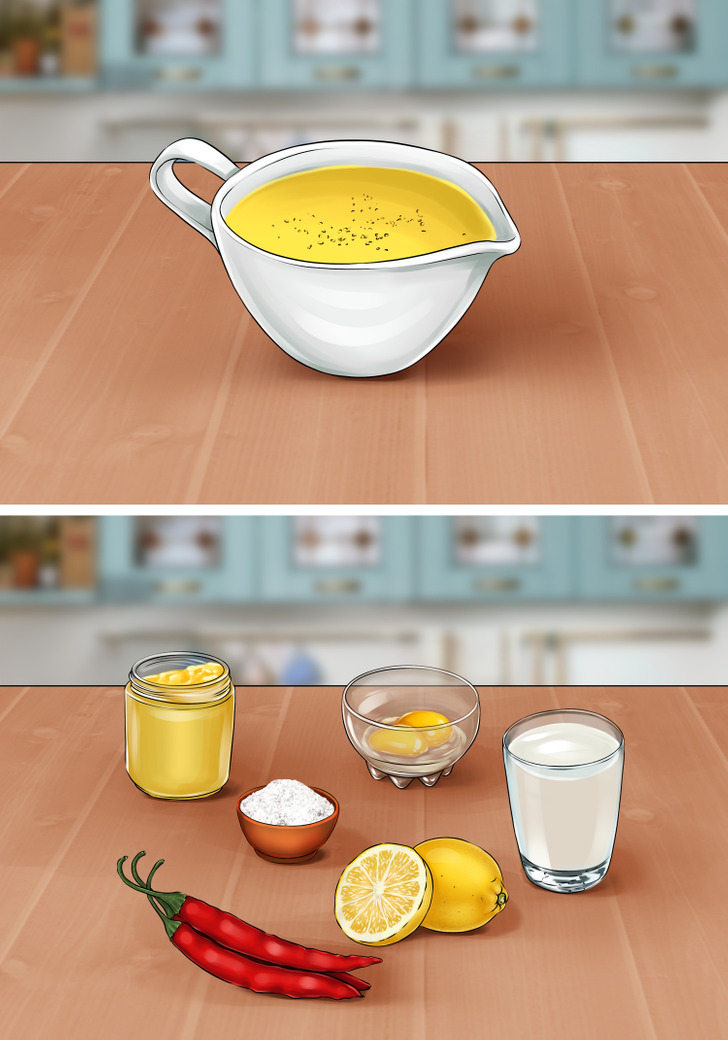
You’ll need:
- 1 cup of clarified butter (should be warm but not hot)
- 4 egg yolks
- 2 tablespoons of lemon juice
- 1 tablespoon of cold water
- Salt
- Cayenne pepper
Cooking process:
1. Mix the egg yolks with a spoonful of cold water in a small bowl.
✅ Please note: Only egg yolks are used in the recipe, so they must first be separated from the whites.
2. Whisk the mixture for a couple of minutes until it becomes light and foamy. Then add a few drops of lemon juice to it.
3. Bring a small amount of water to a boil in a saucepan on the stove. Continue to whisk the yolks directly above the saucepan of simmering water, using the steam to heat the mixture lightly.
❗ Please note: The water should not come into contact with the bottom of the bowl so that the egg mixture doesn’t get gummy.
4. Put the bowl on the table and start adding melted butter to the yolks very slowly — just a few drops at a time. At the same time, you should whisk the mixture constantly so that the butter is evenly dispersed.
5. After you’ve added the butter, the sauce will begin to thicken. As it thickens, the amount of butter added can be increased.
6. Add the remaining lemon juice, salt, and Cayenne pepper (or a few drops of Tabasco sauce) to the sauce.
7. Check whether the sauce is ready — it should have a smooth, firm consistency. If the sauce is too thick, add a few drops of warm water to it and stir the mixture.
Classic tomato
The classic tomato sauce is cooked by boiling tomatoes with pork fat and broth. It was traditionally thickened with a roux (a mixture of flour and butter), but modern adaptations of the recipe skip this step.
The classic tomato sauce is often used in recipes for lasagne, pasta, pizza, meatballs, and so on.
This sauce is a starting point for many other sauces, such as Spanish sauce, Provençale sauce, Creole sauce, and others.
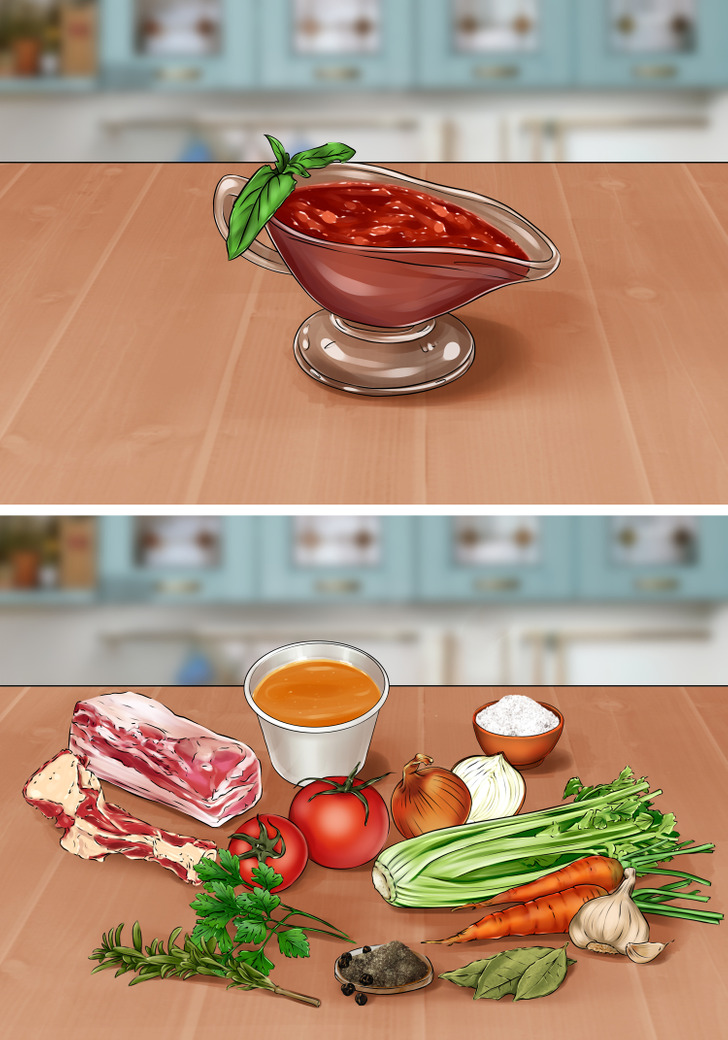
You’ll need:
- 2 ounces of diced salt pork
- 4 garlic cloves, minced
- 1 medium onion, diced
- 1 cup of diced carrots
- 1 cup of diced celery
- 3 1/2 pounds of fresh tomatoes, peeled, seeded, and diced, or 2 28-ounce cans of good quality crushed tomatoes
- 1 quart of veal or chicken broth
- 1 ham bone
- 4 parsley sprigs
- 1 bay leaf
- 2 sprigs of thyme tied in cheesecloth
- Salt and pepper to taste
Cooking process:
1. Preheat the oven to 300°F. In a heatproof bowl or Dutch oven, cook the pork over low heat until the fat has melted.
2. Add garlic, onion, carrot, and celery to the pork, raise the heat to medium, and cook the vegetables until soft (about 3-4 minutes).
3. Add the tomatoes along with the juice, broth, ham bone, and herbs to the mixture. Bring to a boil, cover, and send to the oven for about 2 hours.
4. Remove the mixture from the oven and discard the bone and herbs. Let the mixture cool slightly and then purée the sauce in a blender or food processor until smooth.
5. Add salt and pepper to taste.